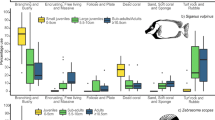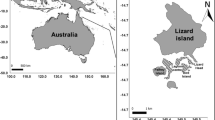Abstract
Food and predation are considered to represent the main factors affecting habitat selection by juvenile reef fish. Generally, coral reefs shelter more invertebrate prey but also harbor more predators compared to vegetated areas. To avoid predation, many juvenile fish may select lower-risk vegetated areas rather than coral reefs. Very little information is known about habitat selection by juvenile fish if coral reefs have similar predation rates as vegetated areas. In this study, we quantified the density, diet, survival rate, and food availability of four reef fish species (Lethrinus harak, L. obsoletus, Lutjanus gibbus, and Parupeneus indicus) as well as predator and competitor density within a low-predation lagoon containing bare sand, coral reefs, and seagrass beds. The results showed that the two lethrinids used seagrass beds as primary habitats as small juveniles. Large juveniles of L. obsoletus (5 cm total length after dietary shift) and most juvenile L. gibbus preferred coral reefs. P. indicus were dietary generalists in most habitats. Overall, these instances of ontogenetic habitat selection may be related to variations in diet in each species. We also found that predation rates were extremely low (<30 %) in both coral and seagrass habitats and that coral reefs sheltered higher invertebrate prey densities (80 ind m−2) than did seagrass beds (30 ind m−2) and bare sand (<10 ind m−2). We hypothesized that competition is a factor potentially affecting habitat selection by juvenile reef fish, as more competitor fish inhabited coral reefs. Fish optimize the advantages of particular habitats for growth and for avoiding competition by selecting ideal habitats under conditions of low predation.





Similar content being viewed by others
References
Adams SM (1976) Feeding ecology of eelgrass fish communities. Trans Am Fish Soc 105:514–519. doi:10.1577/1548-8659(1976)105<514:FEOEFC>2.0.CO;2
Adams AJ, Dahlgren CP, Kellison GT, Kendall MS, Layman CA, Ley JA, Nagelkerken I, Serafy JE (2006) Nursery function of tropical back-reef systems. Mar Ecol Prog Ser 318:287–301. doi:10.3354/meps318287
Almany GR, Webster MS (2006) The predation gauntlet: early post-settlement mortality in reef fishes. Coral Reefs 25:19–22. doi:10.1007/s00338-005-0044-y
Arvedlund M, Takemura A (2006) The importance of chemical environmental cues for juvenile Lethrinus nebulosus Forsskål (Lethrinidae, Teleostei) when settling into their first benthic habitat. J Exp Mar Biol Ecol 338:112–122. doi:10.1016/j.jembe.2006.07.001
Clarke KR, Gorley RN (2006) PRIMER v6: user manual/tutorial. PRIMER-E, Plymouth
Cocheret de la Morinière E, Pollux BJA, Nagelkerken I, Hemminga MA, Huiskes AL, van der Velde G (2003) Ontogenetic dietary changes of coral reef fish during life cycle migrations in the mangrove-seagrass-reef continuum: stable isotopes and gut contents analysis. Mar Ecol Prog Ser 246:279–289. doi:10.3354/meps246279
Dahlgren CP, Eggleston DB (2000) Ecological processes underlying ontogenetic habitat shifts in a coral reef fish. Ecology 81:2227–2240. doi:10.1890/0012-9658(2000)081[2227:EPUOHS]2.0.CO;2
DeMartini EE, Anderson TW, Friedlander AM, Beets JP (2011) Predator biomass, prey density, and species composition effects on group size in recruit coral reef fishes. Mar Biol 158:2437–2447. doi:10.1007/s00227-011-1745-0
Dorenbosch M, Grol MGG, Christianen MJA, Nagelkerken I, van der Velde G (2005a) Indo-Pacific seagrass beds and mangroves contribute to fish density and diversity on adjacent coral reefs. Mar Ecol Prog Ser 302:63–76. doi:10.3354/meps302063
Dorenbosch M, Grol MGG, Nagelkerken I, van der Velde G (2005b) Distribution of coral reef fishes along a coral reef-seagrass gradient: edge effects and habitat segregation. Mar Ecol Prog Ser 299:277–288. doi:10.3354/meps299277
Dorenbosch M, Grol MGG, Groene A, van der Velde G, Nagelkerken I (2009) Piscivore assemblages and predation pressure affect relative safety of some back-reef habitats for juvenile fish in a Caribbean bay. Mar Ecol Prog Ser 379:181–196. doi:10.3354/meps07896
Feeney WE, Lönnstedt OM, Bosiger Y, Martin J, Jones GP, Rowe RJ, McCormick MI (2012) High rate of prey consumption in a small predatory fish on coral reefs. Coral Reefs 31:909–918. doi:10.1007/s00338-012-0894-z
Grol MGG, Dorenbosch M, Kokkelmans EM, Nagelkerken I (2008) Mangroves and seagrass beds do not enhance growth of early juveniles of a coral reef fish. Mar Ecol Prog Ser 366:137–146. doi:10.3354/meps07509
Grol MGG, Nagelkerken I, Rypel AL, Layman CA (2011) Simple ecological trade-offs give rise to emergent cross-ecosystem distributions of a coral reef fish. Oecologia 165:79–88. doi:10.1007/s00442-010-1833-8
Grol MGG, Rypel AL, Nagelkerken I (2014) Growth potential and predation risk drive ontogenetic shifts among nursery habitats in a coral reef fish. Mar Ecol Prog Ser 502:229–244. doi:10.3354/meps10682
Hixon MA, Jones GP (2005) Competition, predation, and density-dependent mortality in demersal marine fishes. Ecology 86:2847–2859. doi:10.1890/04-1455
Holbrook SJ, Schmitt RJ (2002) Competition for shelter space causes density-dependent predation mortality in damselfishes. Ecology 83:2855–2868. doi:10.1890/0012-9658(2002)083[2855:CFSSCD]2.0.CO;2
Hurlbert SH (1978) The measurement of niche overlap and some relatives. Ecology 59:67–77. doi:10.2307/1936632
Hyslop EJ (1980) Stomach contents analysis: a review of methods and their application. J Fish Biol 17:411–429. doi:10.1111/j.1095-8649.1980.tb02775.x
Jones GP (1986) Food availability affects growth in a coral reef fish. Oecologia 70:136–139. doi:10.1007/BF00377123
Jones GP, McCormick MI (2002) Interaction between energetic and numerical processes in the ecology of coral reef fish populations. In: Sale PF (ed) Coral reef fishes: dynamics and diversity in a complex ecosystem. Academic Press, San Diego, pp 221–238
Kimirei IA, Nagelkerken I, Trommelen M, Blankers P, Van Hoytema N, Hoeijmakers D, Huijbers CM, Mgaya YD, Rypel AL (2013) What drives ontogenetic niche shifts of fishes in coral reef ecosystems? Ecosystems 16:783–796. doi:10.1007/s10021-013-9645-4
Kimirei IA, Nagelkerken I, Griffioen B, Wagner C, Mgaya YD (2011) Ontogenetic habitat use by mangrove/seagrass-associated coral reef fishes shows flexibility in time and space. Estuar Coast Shelf Sci 92:47–58. doi:10.1016/j.ecss.2010.12.016
Liu PJ, Shao KT, Jan RQ, Fan TY, Wong SL, Hwang JS, Chen JP, Chen CC, Lin HJ (2009) A trophic model of fringing coral reefs in Nanwan Bay, southern Taiwan suggests overfishing. Mar Environ Res 68:106–117. doi:10.1016/j.marenvres.2009.04.009
McCormick MI, Hoey AS (2004) Larval growth history determines juvenile growth and survival in a tropical marine fish. Oikos 106:225–242. doi:10.1111/j.0030-1299.2004.13131.x
Munday PL, Jones GP, Caley MJ (2001) Interspecific competition and coexistence in a guild of coral-dwelling fishes. Ecology 82:2177–2189
Nagelkerken I (2009) Evaluation of nursery function of mangroves and seagrass beds for tropical decapods and reef fishes: patterns and underlying mechanisms. In: Nagelkerken I (ed) Ecological connectivity among tropical coastal ecosystems. Springer, Netherlands, pp 357–399
Nagelkerken I, Roberts CM, van Der Velde G, Dorenbosch M, Van Riel MC, Cocheret de la Morinière E, Nienhuis PH (2002) How important are mangroves and seagrass beds for coral-reef fish? The nursery hypothesis tested on an island scale. Mar Ecol Prog Ser 244:299–305. doi: 10.3354/meps244299
Nagelkerken I, van der Velde G, Verberk WCEP, Dorenbosch M (2006) Segregation along multiple resource axes in a tropical seagrass fish community. Mar Ecol Prog Ser 308:79–89. doi:10.3354/meps308079
Nakamura Y, Sano M (2004a) Is there really lower predation risk for juvenile fishes in a seagrass bed compared with an adjacent coral area? Bull Mar Sci 74:477–482
Nakamura Y, Sano M (2004b) Overlaps in habitat use of fishes between a seagrass bed and adjacent coral and sand areas at Amitori Bay, Iriomote Island, Japan: importance of the seagrass bed as juvenile habitat. Fish Sci 70:788–803. doi:10.1007/s102280300002
Nakamura Y, Tsuchiya M (2008) Spatial and temporal patterns of seagrass habitat use by fishes at the Ryukyu Islands, Japan. Estuar Coast Shelf Sci 76:345–356. doi:10.1016/j.ecss.2007.07.014
Nakamura Y, Horinouchi M, Nakai T, Sano M (2003) Food habits of fishes in a seagrass bed on a fringing coral reef at Iriomote Island, southern Japan. Ichthyol Res 50:15–22. doi:10.1007/s102280300002
Nakamura Y, Shibuno T, Lecchini D, Kawamura T, Watanabe Y (2009) Spatial variability in habitat associations of pre-and post-settlement stages of coral reef fishes at Ishigaki Island, Japan. Mar Biol 156:2413–2419. doi:10.1007/s00227-009-1257-3
Nakamura Y, Hirota K, Shibuno T, Watanabe Y (2012) Variability in nursery function of tropical seagrass beds during fish ontogeny: timing of ontogenetic habitat shift. Mar Biol 159:1305–1315. doi:10.1007/s00227-012-1911-z
Overholtzer KL, Motta P (1999) Comparative resource use by juvenile parrotfishes in the Florida Keys. Mar Ecol Prog Ser 177:177–187. doi:10.3354/meps177177
Paine RT (1969) A note on trophic complexity and community stability. Am Nat 103:91–93. doi:10.1086/282586
Pogoreutz C, Kneer D, Litaay M, Asmus H, Ahnelt H (2012) The influence of canopy structure and tidal level on fish assemblages in tropical Southeast Asian seagrass meadows. Estuar Coast Shelf Sci 107:58–68. doi:10.1016/j.ecss.2012.04.022
Polis GA, Holt RD (1992) Intraguild predation: the dynamics of complex trophic interactions. Trends Ecol Evol 7:151–154. doi:10.1016/0169-5347(92)90208-S
Risk A (1997) Effects of habitat on the settlement and postsettlement success of the ocean surgeonfish Acanthurus bahianus. Mar Ecol Prog Ser 161:51–59. doi:10.3354/meps161051
Sala E, Ballesteros E (1997) Partitioning of space and food by three fish of the genus Diplodus (Sparidae) in a Mediterranean rocky infralittoral ecosystem. Mar Ecol Prog Ser 152:273–283. doi:10.3354/meps152273
Schmitt RJ, Holbrook SJ (1999) Settlement and recruitment of three damselfish species: larval delivery and competition for shelter space. Oecologia 118:76–86. doi:10.1007/s004420050705
Schmitz OJ, Krivan V, Ovadia O (2004) Trophic cascades: the primacy of trait-mediated indirect interactions. Ecol Lett 7:153–163. doi:10.1111/j.1461-0248.2003.00560.x
Schoener TW (1970) Nonsynchronous spatial overlap of lizards in patchy habitats. Ecology 51:408–418. doi:10.2307/1935376
Stallings CD (2008) Indirect effects of an exploited predator on recruitment of coral-reef fishes. Ecology 89:2090–2095. doi:10.1890/07-1671.1
Sweatman HP (1984) A field study of the predatory behavior and feeding rate of a piscivorous coral reef fish, the lizardfish Synodus englemani. Copeia 1:187–194. doi:10.2307/1445051
Unsworth RKF, De León PS, Garrard SL, Smith DJ, Bell JJ (2009a) Habitat usage of the thumbprint emperor Lethrinus harak (Forsskål, 1775) in an Indo-Pacific coastal seascape. Open Mar Biol J 3:16–20. doi:10.2174/1874450800903010016
Unsworth RKF, Garrard SL, De León PS, Cullen LC, Smith DJ, Sloman KA, Bell JJ (2009b) Structuring of Indo-Pacific fish assemblages along the mangrove–seagrass continuum. Aquat Biol 5:85–95. doi:10.3354/ab00139
Unsworth RKF, Hinder SL, Bodger OG, Cullen-Unsworth LC (2014) Food supply depends on seagrass meadows in the coral triangle. Environ Res Lett 9:094005. doi:10.1088/1748-9326/9/9/094005
Wen CKC, Pratchett MS, Almany GR, Jones GP (2013) Role of prey availability in microhabitat preferences of juvenile coral trout (Plectropomus: Serranidae). J Exp Mar Biol Ecol 443:39–45. doi:10.1016/j.jembe.2013.02.027
Acknowledgments
We thank Yi-Li Chuang and Chen-Yun Lee for field assistance and Laurie Battle for proofreading the manuscript. This study was financially supported by Kenting National Park Headquarters, the National Science Council of Taiwan (Grant No. NSC101-2625-M-005-004) and the National Natural Science Foundation of China (Grant No. U1405234).
Author information
Authors and Affiliations
Corresponding author
Additional information
Communicated by D. Goulet.
Reviewed by undisclosed experts.
Rights and permissions
About this article
Cite this article
Lee, CL., Lin, HJ. Ontogenetic habitat utilization patterns of juvenile reef fish in low-predation habitats. Mar Biol 162, 1799–1811 (2015). https://doi.org/10.1007/s00227-015-2712-y
Received:
Accepted:
Published:
Issue Date:
DOI: https://doi.org/10.1007/s00227-015-2712-y




